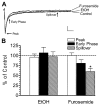Alcohol enhances GABAergic transmission to cerebellar granule cells via an increase in Golgi cell excitability
- PMID: 15084654
- PMCID: PMC6729340
- DOI: 10.1523/JNEUROSCI.0067-04.2004
Alcohol enhances GABAergic transmission to cerebellar granule cells via an increase in Golgi cell excitability
Abstract
Alcohol intoxication alters coordination and motor skills, and this is responsible for a significant number of traffic accident-related deaths around the world. Although the precise mechanism of action of ethanol (EtOH) is presently unknown, studies suggest that it acts, in part, by interfering with normal cerebellar functioning. An important component of cerebellar circuits is the granule cell. The excitability of these abundantly expressed neurons is controlled by the Golgi cell, a subtype of GABAergic interneuron. Granule cells receive GABAergic input in the form of phasic and tonic currents that are mediated by synaptic and extrasynaptic receptors, respectively. Using the acute cerebellar slice preparation and patch-clamp electrophysiological techniques, we found that ethanol induces a parallel increase in both the frequency of spontaneous IPSCs and the magnitude of the tonic current. EtOH (50 mm) did not produce this effect when spontaneous action potentials were blocked with tetrodotoxin. Recordings in the loose-patch cell-attached configuration demonstrated that ethanol increases the frequency of spontaneous action potentials in Golgi cells. Taken together, these findings indicate that ethanol enhances GABAergic inhibition of granule cells via a presynaptic mechanism that involves an increase in action potential-dependent GABA release from Golgi cells. This effect is likely to have an impact on the flow of information through the cerebellar cortex and may contribute to the mechanism by which acute ingestion of alcoholic beverages induces motor impairment.
Figures






References
-
- Aguayo LG, Peoples RW, Yeh HH, Yevenes GE (2002) GABA(A) receptors as molecular sites of ethanol action. Direct or indirect actions? Curr Top Med Chem 2: 869–885. - PubMed
-
- Aitken PG, Breese GR, Dudek FF, Edwards F, Espanol MT, Larkman PM, Lipton P, Newman GC, Nowak Jr TS, Panizzon KL, Raley-Susman KM, Reid KH, Rice ME, Sarvey JM, Schoepp DD, Segal M, Taylor CP, Teyler TJ, Voulalas PJ (1995) Preparative methods for brain slices: a discussion. J Neurosci Methods 59: 139–149. - PubMed
-
- Appel SB, Liu Z, McElvain MA, Brodie MS (2003) Ethanol excitation of dopaminergic ventral tegmental area neurons is blocked by quinidine. J Pharmacol Exp Ther 306: 437–446. - PubMed
-
- Crowder TL, Ariwodola OJ, Weiner JL (2002) Ethanol antagonizes kainate receptor-mediated inhibition of evoked GABA(A) inhibitory postsynaptic currents in the rat hippocampal CA1 region. J Pharmacol Exp Ther 303: 937–944. - PubMed
Publication types
MeSH terms
Substances
LinkOut - more resources
Full Text Sources
